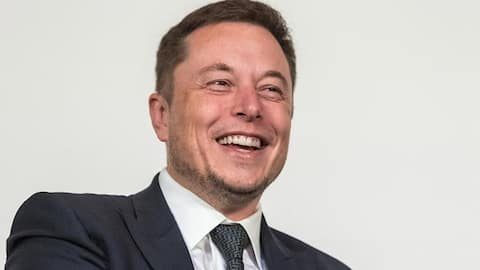Musk gives live demo of Neuralink's upgraded brain-computer implant
What's the story
A few hours ago, Elon Musk took to the stage to unveil the upgraded brain-computer implant developed by Neuralink, a start-up he co-founded in 2016 to connect humans with machines.
The device builds on the one debuted last year, and the billionaire tech mogul also gave a live demo of how it works - on pigs.
Here is all about it.
Last year
The tech debuted last year
Last year, Musk demonstrated a sewing machine-like surgical robot to implant thin and flexible electrode-covered wires into the head of a person and a receiver module on the skull's surface, near the ear.
This receiver picked up signals from the electrodes and subsequently transmitted them to a computer; it was smaller than other BCIs in the market but still big enough to be seen.
Device
Now, there's an all-in-one design, sitting flush with the skull
In today's event, the Tesla boss showcased a V2 prototype of the automated surgical system which can insert the implant in under an hour without general anesthesia.
More importantly, the implant itself has gotten smaller in favor of an all-in-one design, where the wire electrodes are 5 micron-wide while the receiver they connect to is coin-shaped, meant to sit flush with the skull.
Do you know?
Receiver module not even visible
The design changes are so significant that the receiver, dubbed Link 0.9, is not even visible. It measures just 23mm x 8mm in size and is surgically positioned in place. Musk described the whole thing "like a Fitbit in your skull with tiny wires."
Demo
Musk gave a live demo of the tech
At the event, Musk gave a demo of the tech with three pigs - one that never had an implant, second that had it, and the third that had it only for some time.
Through the first and the third case, Musk emphasized that both pigs behaved as usual, which shows that the implant could be removed for potential hardware upgrades, without any issues.
Second pig
Second pig's neural activity displayed in real-time
The second pig in the demo, Gertrude, had the Link recording signals from an area of the brain that was linked to its snout.
This way, as Gertrude touched and smelled, the neural interface it had in place for two months picked up signals of neurons firing.
The signals were displayed through a series of dots and noises on a display.
Working
Currently, tech detects signals from brain's surface
In its current form, Neuralink's brain-computer interface only records and transmits signals from the brain's cortical surface - the region responsible for important functions like movement, vision, and hearing.
However, eventually, the company plans to insert them deeper into the grey matter to monitor deeper brain activity. There are not many details around this yet.
Target
Plan to have 1,024 electrodes implanted
Neuralink hopes that the system will allow them to implant thin, flexible wires covered in 1,024 electrodes to pick up brain activity and transmit that data through Link at megabit speeds.
Musk says that they have managed to implant 1,500 electrodes in mice, although human trials are yet to begin. Previously, he had suggested that the device would go into a human in 2020.
Possibilities
Work will help in solving neurological problems, physical injuries
With Neuralink's BCI to monitor and stimulate brain activity, people should be able to get early warnings of imminent strokes and heart attacks.
Plus, the device might be able to solve several neurological problems, including memory loss and strokes, and also help patients regain their lost senses of sight or hearing.
The first trials will see patients with spinal cord injuries have the implant.
Information
How much will this cost?
Musk says that the tech will be quite expensive when it launches but eventually it will retail at the same price of a LASIK vision correction procedure. Take it with a pinch of salt.
Ultimate goal
Ultimate goal to establish a symbiosis with AI
The developments with this technology will ultimately build towards a system that will help Neuralink "achieve a symbiosis with artificial intelligence".
This would help humans keep up with the advancement of AI and ensure the "democratization of intelligence" by keeping it from staying in a purely digital form.
Musk says this particular symbiosis could be a reality in the order of a decade.
